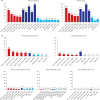Preventable Cancers Caused by Infection in Korea From 2015 to 2030
- PMID: 40625045
- PMCID: PMC12235194
- DOI: 10.3346/jkms.2025.40.e143
Preventable Cancers Caused by Infection in Korea From 2015 to 2030
Abstract
Background: To contribute to evidence-based cancer prevention policies, we conducted a systematic assessment to estimate the burden of infection-related cancers in South Korea. We estimated the population-attributable fraction (PAF) of each cancer attributable to the causally related infectious agents between 2015 and 2030.
Methods: The relative risks of cancer due to infectious agents were calculated using a meta-analysis of results from large-scale Korean cohort studies combined with results from a systematic review of South Korean studies. We calculated the attributable cancer incidence and mortality in 2015 and 2020 from nationwide cancer statistics, assuming a 15-year latency period, and projected them for 2025 and 2030.
Results: The estimated attributable cancer cases were 28,420 (13.18%) in 2015 and 26,368 (10.70%) in 2020 for all new cancer cases due to infectious agents. Attributable cancer deaths were 11,292 (14.74%) in 2015 and 9,969 (12.15%) in 2020 for all new cancer mortalities. Helicobacter pylori occupied the largest proportion of cancer incidence (5.93%), followed by hepatitis B virus (HBV) (2.45%) and human papillomavirus (HPV) (1.74%), and the first cause of cancer death was HBV (5.24%), followed by H. pylori (4.62%) and HPV (1.41%) in 2020. The PAFs were predicted to decline to 9.35% (2025) and 8.99% (2030) for incidence, and to 10.18% (2025) and 10.02% (2030) for mortality.
Conclusion: Fractions of cancer cases and mortality due to infectious agents are projected to decrease from 2015 to 2030. There should be adequate intervention from authorities to control H. pylori, HBV, and HPV and to reduce the cancer burden.
Keywords: 2015; 2020; Cancer; Infectious Agents; Population Attributable Fraction; South Korea.
© 2025 The Korean Academy of Medical Sciences.
Conflict of interest statement
The authors have no potential conflicts of interest to disclose.
Figures


References
-
- Choi IJ, Kim CG, Lee JY, Kim YI, Kook MC, Park B, et al. Family history of gastric cancer and Helicobacter pylori treatment. N Engl J Med. 2020;382(5):427–436. - PubMed
-
- Bouvard V, Baan R, Straif K, Grosse Y, Secretan B, El Ghissassi F, et al. A review of human carcinogens--part B: biological agents. Lancet Oncol. 2009;10(4):321–322. - PubMed
-
- Shin A, Park S, Shin HR, Park EH, Park SK, Oh JK, et al. Population attributable fraction of infection-related cancers in Korea. Ann Oncol. 2011;22(6):1435–1442. - PubMed
Publication types
MeSH terms
Grants and funding
LinkOut - more resources
Full Text Sources
Medical

